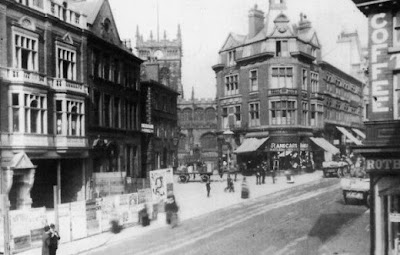
This is Wigan in 1910: Wallgate
In 2009 my wife, Connie, and I took a cruise to Western Europe on the Grand Princess. There were about 200 Americans sailing with over 2000 British people. When I told the Brits my family came from Wigan, they often responded with laughter. I was told back in the vaudeville days British comedians often made fun of Wigan because of its strange name. When I told the Brits that we would be staying in Wigan for 5 days, we were met with total and complete disbelief. Who in their right mind would spend any time in Wigan on holiday? There is nothing there to attract a tourist. The answer would be myself for one, and my wife would make two and my daughter would make three! Actually, my wife, my daughter and I like it there, especially the nearby village of Aspull.
To find Wigan on a map of England, you can draw a line between the cities of Manchester and Liverpool in Lancashire County in the northwest of England. Wigan would be about half way and north. Within a short distance of Wigan there are a number of smaller villages that either are a part of metropolitan Wigan or they are very close to it (see mileage chart below). These places have names like Aspull, Ince, Haigh, Scholes (a neighborhood in Wigan) and Blackrod (associated more with Bolton than Wigan). These will be the places that the Moore’s and other related families would live prior to and through the nineteenth century until they immigrated to Canada in 1903.
In the nineteenth century there was not much in Wigan except for two things. The first was coal and lots of it. Second was an abundance of cheap labor to work in the coal mines. That alone would place Wigan at very heart of the English industrial revolution. In the 1800 and starting even before that, the Wigan area was dotted with mining operations one after another after another. And each mining operation was worked by the desperately poor like the Moore’s and other related families like the Cunliffes, Blinkhorns, Watmaugh’s and Fishwicks just to name a few.
It was the coal that England needed for its industrialization and empire building. It was the coal provided power for the factories. It was the fuel for the ships that connected the far flung English colonies around the world and for the British navy that “protected” and maintained these colonies. England needed the coal and it was with the labor of the Wigan coal miners and other coal miners in England that supplied the empire with its power.
After a while Wigan developed a second industry. That would be textile mills. The mills would employ women to operate the machines and weave the cloth.
The mines and the mills would compete over who would get the cheap female labor in that both would use woman workers. Whether you were working the pits or the mills you worked under terrible conditions with very little pay. This was especially true with the women and girls who worked the mines who were called the Pit Brow Lassies. More about them later.
England was ground zero of the industrial revolution in Europe, and Wigan was at ground zero of the English industrialization. It was in this environment the Moore’s and related families lived, worked and in the end survived.
Wigan Area Mileage Chart:
Wigan to Aspull 2.9 Miles
Aspull to Blackrod 2.0 Miles
Blackrod to Wigan 4.9 Miles
Wigan to Ince 1.6 miles
Aspull to Haigh 0.8 Miles
Ince to Aspull 3.0 Miles
(Source for Wigan photograph: www.wiganworld.co.uk http://www.wiganworld.co.uk/oldgallery/soldphoto.php?pic=wig2l.jpg&w=520&h=331&opt=g3)
Copyright 2011 Paul Moore






